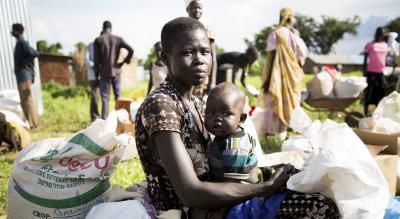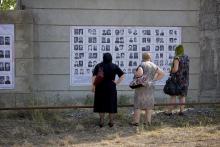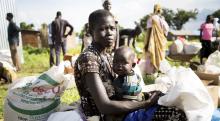Case prepared by Pierpaolo Castiglioni, Yiota Constantinidi, Fiammetta Ferioli, LL.M. students at Roma Tre University under the supervision of Giulio Bartolini (Professor) and Tommaso Natoli (Research assistant), Roma Tre University IHL Legal Clinic, and Clara Burkard, Ashwin Manoharan and Yildiz Miller, LL.M. students at Leiden University, under the supervision of Professor Robert Heinsch as well as Sofia Poulopoulou and Christine Tremblay (PhD researchers/research assistants), Kalshoven-Gieskes Forum, Leiden University; with the contribution of Jemma Arman and Isabelle Gallino, LL.M. students at the Geneva Academy.
A. AGREEMENT ON HUMANITARIAN CORRIDOR BETWEEN SUDAN AND SOUTH SUDAN
August 26, 2014 (KHARTOUM) - The United Nations Office for the Coordination of Humanitarian Affairs (OCHA) in Sudan said that representatives from the Governments of Sudan and South Sudan have approved an operational plan that will open a humanitarian corridor between the two countries.
The plan, which was developed and prepared by the UN World Food Programme (WFP), will enable the latter to deliver close to 63,000 metric tonnes of life-saving food assistance to 744,000 people in the northern parts of South Sudan who have been affected by the conflict in South Sudan since December 2013.
Following a meeting with the then head of UN Mission in South Sudan (UNMISS), Hilde Johnson, last June, Sudan’s first vice-president Bakri Hassan Saleh agreed to facilitate the transportation of humanitarian assistance to South Sudan.
Last month, the two countries signed a memorandum of understanding to allow the expedition of aid across its border and river transport to feed thousands of affected civilians.
Johnson said that the UN relies heavily on Sudan to deliver humanitarian assistance to the people of South Sudan, besides contributing to resolving the ongoing conflict in the newborn state.
She also praised Sudanese government role in the IGAD [Intergovernmental Authority on Development in Eastern Africa] led mediation between warring parties in South Sudan, saying it can play a significant role in the search for a solution to South Sudan’s crisis.
The humanitarian situation in South Sudan has deteriorated drastically as result of the violence that erupted in the country since 15 December 2013. UN agencies estimate that, over 1,3 million people have been affected by the conflict and are in need of assistance.
The UN resident and humanitarian coordinator in Khartoum, Ali Al-Za’tari, said in statement on Tuesday that the approval of the operational plan puts the UN in a better position to respond to the growing humanitarian needs of the conflict-affected and vulnerable people in South Sudan, particularly those in the states of Jonglei, Unity and Upper Nile, which share a border with Sudan.
He added that cooperation between the two governments leads to better serves interests of the two people[s]. […]
B. THE IMPLEMENTATION OF THE AGREEMENT
The United Nations World Food Programme (WFP) welcomes the safe arrival of the first convoy of food assistance moved through Sudan to South Sudan.
Eighteen trucks transporting 700 metric tons of food, enough to feed about 45,000 people for one month, have arrived in Upper Nile state from Kosti marking the opening of a humanitarian corridor to enable the delivery of food assistance to South Sudan through the Republic of Sudan.
“Reopening this humanitarian corridor from Sudan will help reduce our heavy reliance on costly air operations to provide assistance in conflict affected areas of South Sudan,” said WFP South Sudan Country Director Joyce Luma. “This will allow WFP and partners to reach more vulnerable people with the urgent food assistance that they need.”
The current cross-border operation will see WFP use trucks and river barges to deliver a total of 4,650 metric tons of food to feed around 275,000 people for one month in the northern parts of South Sudan who have been affected by the conflict. Airdrops and airlifts of food are critical in sustaining food assistance to remote areas but cost six to seven times more than delivery by barge or road.
Since the start of the crisis in South Sudan in December 2013, WFP has reached 2.5 million people with lifesaving food and nutrition assistance.
C. EXTENSION OF THE AGREEMENT ON HUMANITARIAN CORRIDOR
On 10 January, Sudan, South Sudan and the World Food Programme (WFP) signed an extension of the agreement on the transit of humanitarian aid via Sudan to South Sudan for another six months until 30 June 2016. In July 2014, Juba and Khartoum signed a Memorandum of Understanding (MoU) to allow the transport of aid across borders and by river transport to feed thousands of affected civilians in South Sudan.
A considerable part of South Sudanese civilians in need of assistance are located in Upper Nile, Jonglei and Unity states bordering on Sudan, with the delivery of aid supplies via Sudan easier logistically. Since July 2014, WFP has delivered 27,000 metric tons (MT) of food assistance for an estimated 300,000 people in northern states of South Sudan (Maban, Melut, Renk and Wadakona) through Sudan by road, river and air transport. People in these areas mainly depend on food assistance delivered via this corridor.
D. THE USE OF A NEW ROUTE FOR MORE ASSISTANCE
May 7, 2017 (KHARTOUM) - A seventh humanitarian assistance caravan including 1,752 metric tonnes of sorghum Sunday has been dispatched from the capital of Sudan’s North Kordofan state, El-Obeid to the needy population in South Sudan.
Three United Nations agencies declared an outbreak of famine in the young nation in February, saying an additional 1 million people were are the brink of starvation.
On 30 June, the World Food Programme (WFP) began providing food assistance to South Sudan using a new corridor opened by Sudan. The new route enables transport of food items overland from El Obeid in central Sudan to Bentiu in South Sudan’s Unity state.
The Humanitarian aid commissioner Ahmed Babiker al-Hassan has told the official news agency SUNA that the sixth batch included 1,068 metric tonnes of sorghum, pointing to ongoing arrangements to open a new humanitarian corridor from El-Obeid to Awil town in South Sudan via Al-Muglad.
He said the new corridor would contribute significantly to the delivery of the assistance, pointing they developed a plan to transport 2,000 metric tonnes weekly to South Sudan. […]
Last month, Sudan said it doesn’t rule out to open an Airbridge to deliver food assistance to South Sudan during the rainy season revealing a proposal to open a third road corridor to transport aid to the needy population in the war-torn nation. […]
Discussion
I. Classification of the Situation and Applicable Law
1. How would you classify the situation in South Sudan? What additional information would you require in order to make such a determination? Under which conditions would Additional Protocol II be applicable? (
GC I-IV, Art. 3;
P II, Art. 1)
II. Humanitarian Assistance
2. Who has the primary obligation under international humanitarian law to supply the civilian population from lack of essential goods? Do States have similar obligations under IHL of international armed conflict and non-international armed conflicts taking place on their territory? (
GC IV, Art. 55(1);
P I, Art. 69;
P II, Art. 18(2); CIHL, Rule 55)
5. Is the consent of the State always necessary for humanitarian access? When would the consent be considered as “arbitrarily denied”? In non-international armed conflicts, should the armed group give consent when it controls part of the territory? (
GC IV, Arts 23,
55,
59;
P I, Arts 69 and
70;
P II, Art. 18(2); CIHL, Rule 55)
6. Does access to humanitarian assistance also include the freedom of movement of humanitarian relief personnel? When can this be restricted? (
CIHL, Rule 56)
III. Elements Contributing to Respect for IHL
7. What is the aim of the humanitarian corridor established by the parties? What benefits do you see in developing it with the help of an entity such as the UN World Food Programme? Does this cooperation make a difference in terms of efficiency? In terms of visibility? In terms of material support?
8. (Document A) The UN humanitarian coordinator in Khartoum affirmed that the “cooperation between the two governments leads to better serve interests of the two people[s]”. In your opinion, what can the benefits be for South Sudan? For Sudan?
9. How will the operational plan of 2014, and the subsequent humanitarian corridors, be perceived by the international community? What about the population of South Sudan? Why? Do you think that such an action can lead to increased respect for a State?






